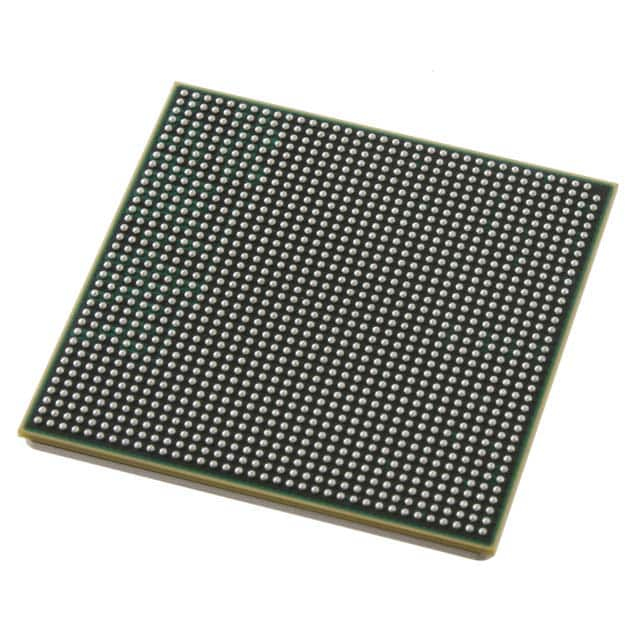Szczegóły produktu można znaleźć w specyfikacjach.

P3041NXE1PNB
Basic Information Overview
- Category: Integrated Circuit (IC)
- Use: Processor
- Characteristics: High-performance, low-power consumption
- Package: BGA (Ball Grid Array)
- Essence: PowerPC-based processor
- Packaging/Quantity: Single unit
Specifications
- Architecture: Power Architecture
- Core: e500v2
- Clock Speed: 1.5 GHz
- Number of Cores: Single core
- Cache: L1 Instruction Cache: 32 KB, L1 Data Cache: 32 KB, L2 Cache: 512 KB
- Memory Interface: DDR3/DDR3L
- Operating Voltage: 1.0V - 1.3V
- Power Consumption: 6W - 12W
- Temperature Range: -40°C to +105°C
Detailed Pin Configuration
The P3041NXE1PNB has a complex pin configuration with multiple pins for various functions. Please refer to the datasheet or technical documentation provided by the manufacturer for detailed pin configuration information.
Functional Features
- High-performance processing capabilities
- Low-power consumption for energy efficiency
- Support for DDR3/DDR3L memory interface
- Integrated cache for improved data access speed
- PowerPC architecture provides compatibility with existing software and tools
Advantages
- High processing power suitable for demanding applications
- Low power consumption helps reduce energy costs
- Compatibility with PowerPC architecture ensures easy integration into existing systems
- Integrated cache improves overall system performance
Disadvantages
- Single-core design may limit multitasking capabilities
- Limited clock speed compared to some modern processors
- Availability and support may vary depending on the manufacturer
Working Principles
The P3041NXE1PNB is based on the PowerPC architecture and operates as a single-core processor. It executes instructions and performs calculations based on the program code provided. The processor communicates with other components of the system through various interfaces, such as memory interface, input/output ports, and bus systems.
Detailed Application Field Plans
The P3041NXE1PNB is commonly used in applications that require high-performance processing with low power consumption. Some potential application fields include: - Networking equipment - Industrial automation - Embedded systems - Communication infrastructure
Detailed and Complete Alternative Models
- P2020NXE1PNB: Similar architecture with lower clock speed and power consumption
- P4080NXE1PNB: Higher-performance variant with multiple cores and higher clock speed
- T2080NXE1PNB: PowerPC-based processor with integrated hardware acceleration for networking applications
Note: The alternative models mentioned above are just examples and may not represent an exhaustive list. Please refer to the manufacturer's product lineup for a complete list of alternative models.
This entry provides an overview of the P3041NXE1PNB processor, including its basic information, specifications, pin configuration, functional features, advantages and disadvantages, working principles, application field plans, and alternative models.
Wymień 10 typowych pytań i odpowiedzi związanych z zastosowaniem P3041NXE1PNB w rozwiązaniach technicznych
Sure! Here are 10 common questions and answers related to the application of P3041NXE1PNB in technical solutions:
Q1: What is P3041NXE1PNB? A1: P3041NXE1PNB is a specific model of processor designed by NXP Semiconductors for embedded computing applications.
Q2: What are the key features of P3041NXE1PNB? A2: Some key features of P3041NXE1PNB include a quad-core Power Architecture e500mc processor, integrated security engine, DDR3 memory controller, and various connectivity options.
Q3: What are the typical use cases for P3041NXE1PNB? A3: P3041NXE1PNB is commonly used in networking equipment, industrial automation systems, and other embedded applications that require high-performance processing capabilities.
Q4: What operating systems are supported by P3041NXE1PNB? A4: P3041NXE1PNB supports various operating systems such as Linux, VxWorks, and QNX, which are commonly used in embedded computing environments.
Q5: Can P3041NXE1PNB handle real-time processing requirements? A5: Yes, P3041NXE1PNB is capable of handling real-time processing requirements due to its powerful processor and integrated features like the security engine.
Q6: What interfaces and connectivity options does P3041NXE1PNB offer? A6: P3041NXE1PNB provides multiple interfaces including Ethernet, USB, PCIe, SATA, and GPIOs, enabling seamless integration with various peripherals and external devices.
Q7: Is P3041NXE1PNB suitable for low-power applications? A7: While P3041NXE1PNB is not specifically designed for low-power applications, it offers power management features that can be utilized to optimize power consumption.
Q8: Can P3041NXE1PNB support virtualization? A8: Yes, P3041NXE1PNB supports virtualization technologies, allowing multiple virtual machines to run concurrently on the processor.
Q9: What development tools are available for programming P3041NXE1PNB? A9: NXP provides a range of development tools, including compilers, debuggers, and software libraries, to facilitate programming and application development for P3041NXE1PNB.
Q10: Are there any evaluation boards or development kits available for P3041NXE1PNB? A10: Yes, NXP offers evaluation boards and development kits specifically designed for P3041NXE1PNB, which provide a platform for prototyping and testing applications based on this processor.
Please note that the answers provided here are general and may vary depending on specific requirements and implementation scenarios.

